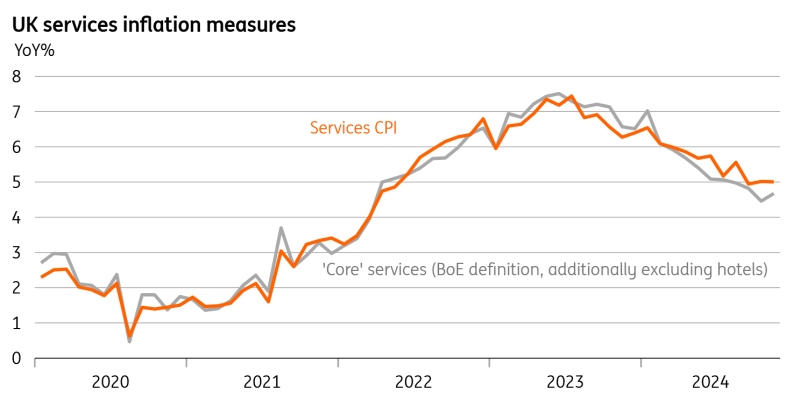Services inflation is stuck at 5% and will stay around there for the next few months. But further progress, helped by more benign annual rises in index-linked prices in April, should see ‘core services’ inflation fall materially in the spring. We think that will be the catalyst for the Bank of England to cut rates a little faster than markets now expect.
UK services inflation is stuck. That’s the main takeaway from the latest UK data, even if it was a tad better than most had expected.
Services CPI stayed at 5.0% for the second consecutive month, though only because of a particularly steep fall in air fares. Once we strip that and other volatile categories out, our measures of so-called “core services” inflation ticked higher.
Indeed our favoured measure, which strips out rents and hotel prices amongst other things, ticked up from 4.5% to 4.7%, having generally been performing better than the headline numbers over recent months.
All of this is really just noise. And in fact, services inflation was still a tad higher than the Bank of England’s most recent forecast, even if it was below everyone else's. Bigger picture, we expect it to bounce around 5% for the next four months or so.
Again though, most of that projected stickiness is likely to be concentrated in categories that the Bank of England has told us it is inclined to pay less attention to. Our core services measure described earlier is likely to get pretty close to 3% next spring.
'Core services' is set to fall close in on 3% in the spring
Source: Macrobond, ING calculations
A lot of the services basket is affected by one-off annual changes in index-linked prices – think of things like phone and internet bills. These are often tied to past rates of headline inflation which, through 2024, has been pretty benign. Those annual price hikes for various services should therefore be less aggressive next April than we saw earlier this year.
If we’re right about that, it should also help overall core inflation to fall materially below 3% in the spring (from 3.5% today). Headline CPI is set to stay a little stickier at 2.6-2.7% in the near-term, thanks to less favourable energy base effects.
If 'core services' inflation does look steadily better, then that would provide some ammunition for the Bank of England to move a little faster on rate cuts than markets are now pricing. Our base case is for back-to-back to rate cuts from February onwards, with Bank Rate falling to 3.25% later in the year.
For the time being though, today’s data means the Bank will stay the course at this week’s meeting. It’ll keep rates on hold and offer no major hints on what’ll come next, beyond re-affirming its commitment to gradual cuts.
Read the original analysis: Sticky UK services inflation to come lower in 2025
Content disclaimer: This publication has been prepared by ING solely for information purposes irrespective of a particular user's means, financial situation or investment objectives. The information does not constitute investment recommendation, and nor is it investment, legal or tax advice or an offer or solicitation to purchase or sell any financial instrument. Read more here: https://think.ing.com/content-disclaimer/
Recommended Content
Editors’ Picks

EUR/USD extends slide toward 1.0300, touches new two-year low
EUR/USD stays under bearish pressure and trades at its lowest level since December 2022 below 1.0350 on Thursday. The pair turned south amid a resurgent US Dollar demand and worsening market mood. Investors stay cautious at the onset of 2025, awaiting the US jobs data for fresh incentives.

GBP/USD slumps to multi-month lows below 1.2450
Following an earlier recovery attempt, GBP/USD reversed its direction and declined to its weakest level in nearly eight months below 1.2450. The renewed US Dollar (USD) strength on worsening risk mood weighs on the pair as markets await mid-tier data releases.

Gold benefits from risk aversion, climbs above $2,640
Gold gathers recovery momentum and trades at a two-week-high above $2,640 heading into the American session on Thursday. The precious metal benefits from the sour market mood and the pullback seen in the US Treasury bond yields.

XRP rockets 11% as Bitcoin starts New Year with bullish bang
Crypto majors zoomed higher in the past 24 hours as the market entered a widely expected bullish year, with Bitcoin inching above $95,000 to shake off losses from last week. XRP surged 11% to lead growth among majors as of Thursday, led by $1.3 billion worth of trading volumes on Korea-focused exchange UpBit.

Three Fundamentals: Year-end flows, Jobless Claims and ISM Manufacturing PMI stand out Premium
Money managers may adjust their portfolios ahead of the year-end. Weekly US Jobless Claims serve as the first meaningful release in 2025. The ISM Manufacturing PMI provides an initial indication ahead of Nonfarm Payrolls.

Best Forex Brokers with Low Spreads
VERIFIED Low spreads are crucial for reducing trading costs. Explore top Forex brokers offering competitive spreads and high leverage. Compare options for EUR/USD, GBP/USD, USD/JPY, and Gold.
